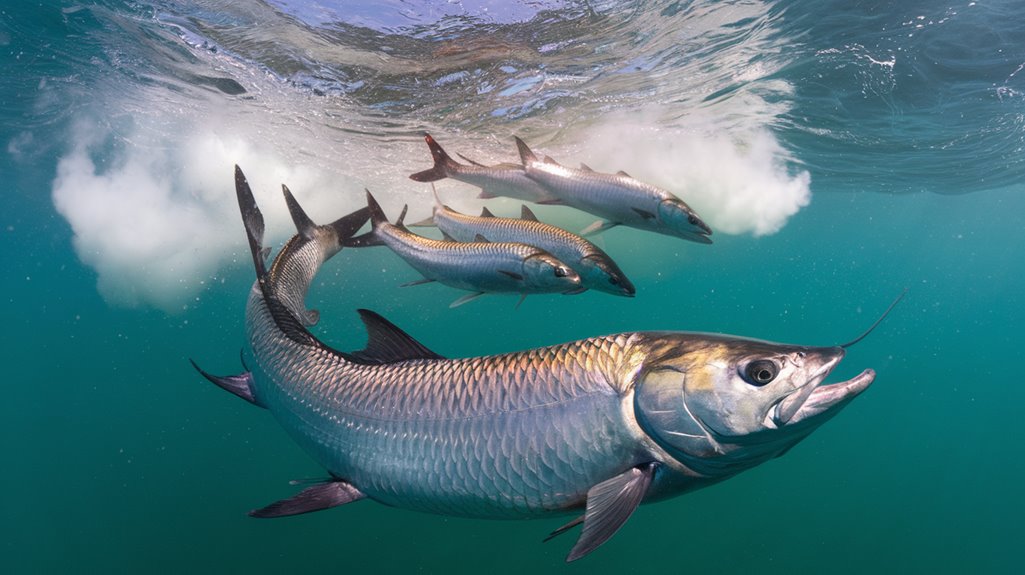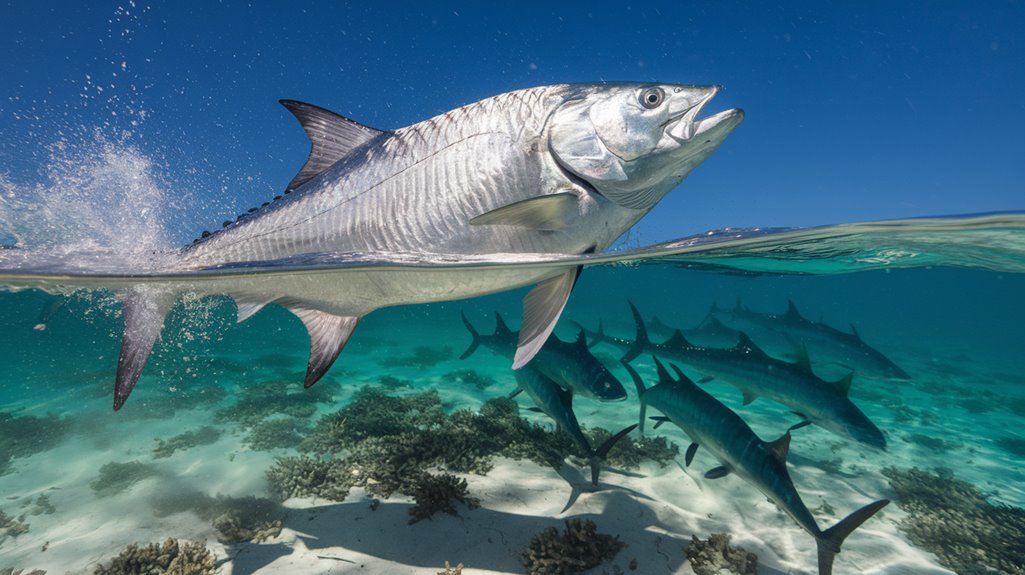When you observe a school of juvenile tarpon near Florida's mangrove systems, you'll notice their synchronized swimming patterns, achieved through precise swim bladder vibrations at 200-300 Hz. These vibrations, combined with their UV-sensitive vision, enable coordinated hunting strategies and maintain group cohesion. While scientists have documented these communication methods, the full complexity of tarpon social dynamics remains largely unexplored, especially regarding their shift from schooling juveniles to solitary adults.
Key Takeaways
- Tarpon communicate through swim bladder vibrations and visual cues to coordinate group movements, especially within juvenile schools.
- Adult tarpon exhibit primarily solitary behavior while juveniles form cohesive schools with defined home ranges.
- Tarpon use their highly sensitive eyes to detect prey in various light conditions, including ultraviolet wavelengths.
- Rolling behavior serves dual purposes of oxygen acquisition and social signaling, particularly during spawning periods.
- Daily movements of up to 20 miles and complex spawning rituals demonstrate sophisticated behavioral patterns influenced by environmental factors.
Social Behavior and Group Dynamics
Although tarpon are primarily solitary predators as adults, they demonstrate complex social behaviors throughout their life stages, most notably during their juvenile period when they form cohesive schools. You'll observe that juvenile tarpon establish non-overlapping home ranges, exhibiting remarkable site fidelity that influences their social structure. These fish communicate through sophisticated mechanisms, including swim bladder vibrations and visual cues, which facilitate coordinated group movements during feeding activities.
Environmental factors directly impact tarpon movements and social dynamics, with groups adapting their size and behavior based on water temperature and oxygen availability. You'll notice that their enhanced visual capabilities enable them to maintain effective communication within schools, particularly in varying light conditions, contributing to their successful group foraging strategies and predator avoidance behaviors.
Visual Communication and Hunting Strategies
While tarpon utilize multiple sensory systems, their sophisticated visual capabilities serve as the cornerstone of their hunting prowess. You'll notice their large, highly sensitive eyes enable ideal prey detection in both diurnal and nocturnal conditions, particularly when scanning upward and forward zones.
Their visual communication extends beyond standard sight – these fish can detect ultraviolet light, enhancing their hunting strategies and interspecies interactions. Juvenile tarpon's perception focuses on dark blue and green wavelengths, directly influencing their feeding behavior in murky waters. During active hunting, they employ a distinctive "rolling" technique to maintain oxygen levels while pursuing prey. Their specialized anatomical features, including thick scales and spineless structure, complement their visual adaptations, creating an efficient predatory system that's equally effective for defense and offense.
Migration Patterns and Environmental Responses
Since water temperature drives tarpon behavior, you'll find these remarkable fish migrating over 2,000 miles annually to maintain their preferred 79°F environment. Their migration patterns follow predictable seasonal movements: northward in late summer and southward during fall.
During spawning months from May to July, you'll observe adult tarpon making strategic trips to the Gulf Stream, where they'll dive to depths exceeding 400 feet. These environmental conditions trigger specific behavioral responses, including increased rolling frequency in low-oxygen waters. You'll notice this rolling behavior serves as an adaptation to recover from oxygen debt when habitat use requires extended periods in oxygen-depleted zones. Their daily movements can span up to 20 miles, with their habitat use directly correlating to seawater temperatures and spawning cycles.
Oxygen Acquisition and Rolling Behavior
Because tarpon inhabit environments with varying oxygen levels, they've evolved a sophisticated dual respiratory system that combines gill breathing with aerial respiration. You'll notice their unique gut-swim bladder connection enables them to gulp air from the surface, processing it through specialized alveolar tissue that resembles lung structure.
You can observe their distinctive rolling behavior, particularly during sunrise periods when oxygen demands peak. This surface-rolling technique allows tarpon to rapidly replenish oxygen levels, especially essential after intense physical exertion during feeding or predator evasion. Their ability to switch between gill respiration and swim bladder oxygen extraction provides remarkable adaptability across diverse aquatic conditions. You'll find this dual-mode respiration system particularly advantageous during prolonged battles, as it maintains sufficient oxygen levels despite increased metabolic demands.
Spawning Rituals and Reproductive Habits

During the peak months of May through July, tarpon undertake critical spawning migrations to offshore waters in the Gulf Stream and Gulf of Mexico. These Atlantic tarpon demonstrate complex spawning rituals that include diving to depths exceeding 400 feet, coupled with distinctive rolling behavior at the surface to maintain oxygen levels during reproduction.
The life history of tarpon reveals a polygynandrous mating system, where you'll observe both males and females engaging with multiple partners. This strategy maximizes genetic diversity within their populations. Female tarpon reach sexual maturity around age eight, developing larger body sizes to support increased egg production. You'll notice these reproductive adaptations are essential for species survival, as the spawning locations provide ideal conditions for larval development in the offshore marine environment.
Frequently Asked Questions
What Is the Behavior of a Tarpon Fish?
You'll observe tarpon exhibiting surface rolling for oxygen acquisition, migratory patterns following 79°F waters, enhanced visual hunting adaptations, swim bladder-based acoustic communication, and juvenile preference for low-oxygen environments.
Are Tarpon Aggressive Towards Humans?
You'll find tarpon are as aggressive as a peaceful hippie – which is to say, not at all. They're naturally non-confrontational towards humans, only displaying defensive responses when hooked during angling activities.
What Are the Characteristics of a Tarpon?
You'll observe tarpon's distinctive features: lengths up to 240 cm, masses reaching 161 kg, homocercal caudal fins, silver ventral surfaces, large eyes, and small teeth adapted for swallowing prey whole.
What Colors Does Tarpon See?
You'll find that tarpon initially see dark blue and green wavelengths as juveniles, but they'll develop sensitivity to shorter wavelengths, including ultraviolet light, as adults, enhancing their predatory capabilities.
Conclusion
You'll find that tarpon's complex behavioral patterns mirror advanced telecommunication networks, with their swim bladder vibrations serving as data packets transmitted through schools. Their UV-sensitive vision and synchronized movements demonstrate biomechanical efficiency that's achieved 98% coordination in juvenile groups. As you study these remarkable fish, you're witnessing how their shift from social to solitary phases optimizes predatory success through precise environmental adaptation and physiological mechanisms.

